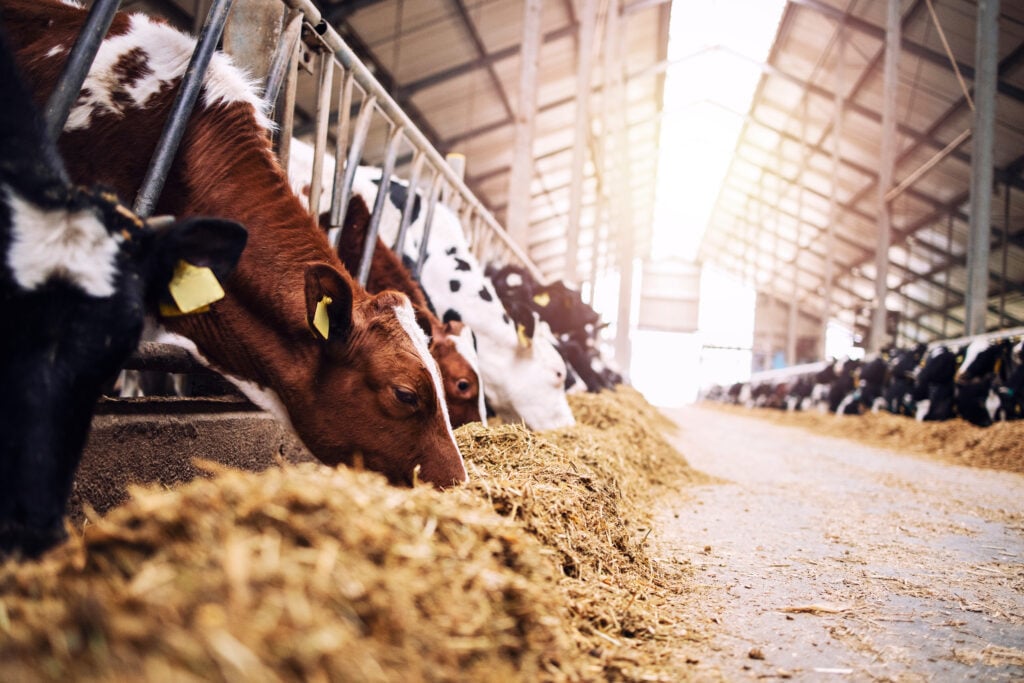Back in 2014, an analytics organization called Faunalytics carried out research to find out how many vegans “quit” and go back to eating meat. When it was published, no one could have predicted the way one headline statistic – that 84 percent of vegetarians and vegans abandon their diet – would dominate the agenda and stick in the minds of those working for (and against) animal protection.
The research promptly went viral. Authors such as Hal Herzog praised the findings, claiming it showed that “animal activists should emphasize reduction, not elimination, of eating meat.”
That somewhat startling figure continues to be used to support a range of reducetarian and incremental approaches to veganism. For example, UK campaign Middle Ground, which claims to support those who care about animals but are unwilling to wholly give up animal products.
Further, the outcome of that 2014 study continues to act as a standard for Faunalytics’ approach to all of its research.
“We consistently recommend against absolutism in advocacy,” says Jo Anderson, research director for Faunalytics, “as it promotes a sense that an aspiring vegan has already failed if they slip once or aren’t ‘quite there’, rather than a sense of pride and continued motivation at a 99 percent accomplishment.”

This “absolutism” or “abolitionist” approach to advocacy, Anderson highlights, is often partly why those who give the diet a try slip back into eating animal products. (I found this to be true in my qualitative research on men and veganism: if it’s a “pass or fail” task, then one “mistake” can lead to the whole attempt being given up.)
The Faunalytics research also concluded that one in eight Americans (the study was conducted in the US on American citizens) had trialed a vegan or vegetarian diet, but only two percent of Americans identified as vegetarian or vegan. Given this, Anderson says, more attention needs to be given to adherence to dietary veganism rather than adoption of the diets.
Criticisms and questions of the study
There were many criticisms of the research at the time – and of the 84 percent figure – that give reason to question if we can use the data to support approaches to vegan outreach today.
For example, how is veganism being defined? (The study was limited to dietary vegans only, yet we know the movement encompasses more than food.) Can you call someone who has tried a plant-based diet once for less than three months a “vegan”? If so, do the vast majority of these “vegans” and “vegetarians” really give up their diet, or do they go back and forth?
And if they do, should vegan activists and organizations reshape their approaches to be more effective in convincing people to change their lifestyles?
“Before we can address those questions with research, we also need to answer what we consider ‘effective’,” Anderson says. “There are different ways to define effectiveness, and maintaining a ‘pure’ vegan or vegetarian diet may be the gold standard, but another key takeaway from the 2014 study is the importance of supporting efforts to reduce, semi-vegetarianism, flexitarianism, and other diets that reduce overall levels of animal suffering.”
For example, the research found that those who did “abandon” their “pure” vegan or vegetarian diets still consumed fewer animal products, especially meat, afterwards. And, 37 percent of those who had tried the diets said they would be willing to do so again, with health the majority reason.
One of the other critical findings was that most of those who gave up their diets had little to no support from a vegan community or network. That’s a reason, perhaps, why the Challenge 22+ model (with mentors) is proving effective.
However, those figures were not so widely reported, or remembered.
Is an abolitionist approach to veganism better?
This argument against “absolutism” in advocacy favors a wide range of approaches instead, such as flexitarianism, Meatless Mondays, and even Veganuary. This upsets some animal rights and vegan activists who consider it a watering down of the key message. And, a betrayal of the animals still suffering in the food production industries.
“The criticism of the research mainly seems to come from the abolitionist angle,” says Tobias Leenaert, author of How to Create a Vegan World, “who don’t seem to want to believe it or who wanted to see in it a confirmation of ‘animal rights’ only advocacy.”
When the research was originally published, Leenaert wrote at length on the findings, arguing:
“It’s all good and well to say that people should be motivated by ethical reasons, but that doesn’t mean they easily will be. It seems to me common sense – and is repeated in much of the change literature I come across – that it is more productive to formulate our message in a way that it connects to values that people already have (health, environment), instead of trying to get them adopt the values we would like them to have.”

He continues to make the point today, telling me that: “People who get into veganism for health reasons can shift to animal reasons, right?”
His argument is that if vegan activists only use “pure” or “animal-only” motivations to encourage people to become vegan, then change will happen more slowly. He agrees, and research suggests, that more people “stick” with veganism if motivated by animal rights reasons. “But what if there would then be less of an inflow of people hearing those reasons, because you don’t use those other (health, environment) arguments to get them?” Leenaert asks.
“I think we need to ask very specific questions about how we can help people maintain their diets,” agrees Anderson.
Yet there are flaws with current research, which need exploring if we’re going to improve our advocacy for animals and grow more fully vegan societies. Do 84 percent of vegans really give up their diets, or, as some argue, is the figure likely to be much lower?
Let’s look at some of the issues and questions:
1. The difference between vegetarians and vegans
Perhaps one of the major flaws in the research is the lack of distinction given to vegans and vegetarians.
Anyone who has made the switch from vegetarian to vegan knows that even if the weekly shopping basket is not quantitively that different, the qualitative difference can be stark and emphatic. Even Anderson from Faunalytics discovered this on her transition from vegetarianism to veganism (or “vegan-ish”) which she expresses eloquently in this blog.
As Anderson writes: “I rolled along happily for years as a vegetarian, secure in that identity – but definitely avoiding information about the egg and dairy industries.”
Dairy remains a major blockage to many making the dietary switch, writes Dr. Neal Barnard in his book The Cheese Trap. This is despite the fact that dairy production is seen by many as more exploitative than beef or other meat products.
It is clear that vegetarian and vegan identities and practices are very different (something I wrote about in my book The Pig in Thin Air). For meaningful research to lead to meaningful advocacy strategies, these identifications and practices must be demarcated and separated in future research. Anderson would go further:
“In our own work, I intend to expand the definition of effectiveness,” she says. “We will report the percentages of people who remain vegan over time, but also those who continue to maintain a reduced-meat diet.”
2. It conflates veganism with diet
“It’s really ‘plant-based eaters’, not ‘vegans’ who are ‘lapsing’ in the research,” says Dr. Matthew Cole, vegan researcher and lecturer in sociology at the Open University in Milton Keynes, England. “If we contend (as I do) that veganism is an ethical commitment to oppose the exploitation of nonhuman animals, then veganism is likely to be far more robust than this research might imply.”
In the Faunalytics study, the majority (58 percent) of those who had tried and then given up on vegetarian/vegan diets had originally adopted the diet for health reasons. This corroborates Cole’s argument: if a vegetarian or vegan diet is only adopted for health, then it isn’t veganism at all, but a plant-based activity.
Counter to Leenaert’s argument above, Cole suggests if the expected health benefits don’t materialize, then people look around for a different diet to follow. Of those who then gave up, a third (34 percent) did so in the first three months, and another 53 percent before the year was up.
When is someone a ‘vegan’?
But Anderson argues this research – which counts those who had tried a vegan diet for six weeks as “vegan” – is still valid.

“Whether you agree or not that people who were vegan for only a short period of time should be included in a study of recidivism, every new vegan has to make it past the first week, first month, first three months,” she stresses.
“It’s the most crucial time in behavior transition so a very necessary research question, just a different one from what some people might have liked to see, if their goal was to find a type of vegan for whom recidivism was low so it ‘looks better’.”
Indeed, such conflation of diets and identities happens on both sides. Positive campaigns such as Veganuary continue to equate veganism with diet only, with its January starter kit focused exclusively on animal-based foods, not clothing or entertainment.
“But vegans, understood as those who oppose all animal exploitation, rather than just followers of a plant-based diet, would be much more resilient and less prone to ‘lapsing’,” argues Cole. “This is one reason why it remains important to contest the meaning of ‘veganism’ and to insist on its relationship to social justice.”
And that’s the finding of another major study, the EPIC-Oxford Study, where vegans self-identified and were found to have strong motivation for and stickiness to their chosen diets.
3. Sample size and contradicting findings
The Faunalytics research, from which the 84 percent figure comes, was initially based on 11,429 North Americans. The follow-up qualitative work (into the reasons why people quit vegetarianism or veganism) was based on a subset of 1,387 respondents.
While these numbers are still reasonable for drawing results, they are far from the largest survey exploring the “staying power” of vegetarians and vegans. The EPIC-Europe Study looks at the dietary choices and related health outcomes of over half a million (521,000) people across ten European countries.
In the UK there were two cohorts, in Norfolk and Oxford. The EPIC-Oxford Study grew out of the Oxford Vegetarian Study (which ran between 1980 and 1986) and looked at the lifestyles of around 65,000 people. The study specifically over-emphasized vegetarian and vegan diets, which made up around 50 percent of all those involved.
Dr. Paul Appleby is a senior statistician at the Oxford Cancer Epidemiology Unit, and a member of the Vegan Society’s Research Advisory Committee. Appleby worked on the EPIC-Oxford Study and continues to publish research based on its findings. The figures here suggest a very different story to those of the Faunalytics figure.
“Data from the EPIC-Oxford study shows that nearly three-quarters of the participants who were vegetarian or vegan at recruitment in the mid to late 1990s were still either vegetarian or vegan when they completed a follow-up questionnaire in 2010,” Appleby told me in personal communication. That is, 73 percent of those who identified as vegetarian or vegan back in the 1990s were still following those dietary lifestyles over 20 years later.
And the recidivism rate is slow. As Dr. Timothy Key, principle investigator on the EPIC-Oxford Study has shown, in their five-year follow-up after the study was first concluded, 85 percent of vegetarians and vegans were still following their chosen diet.
So the recidivism rate after five years was not 84 percent, but the other way around, only 15 percent. And a further fifteen years later it was still not 84 percent, but only 27 percent.
Appleby is hoping to publish this data soon, after which the difference in recidivism rates between veganism and vegetarianism can be more clearly seen. But if you agree with Cole that veganism is a commitment to end the exploitation of animals, then it may be likely that much of that 27 percent would be made up of vegetarians, who were consuming animal products anyway, rather than the vegans.
Does the EPIC study have flaws?
The participants in the EPIC-Oxford Study may have particular characteristics that do not make them representative of new or younger vegans.
“It’s also worth noting of the EPIC-Oxford Study that they included only people over 35, thereby missing the largest target audience for vegan advocacy,” says Anderson.
“No method is perfect and I understand the criticisms of ours,” she adds. “Both the strict definition of diet on the one hand and including dietary instead of lifestyle vegans on the other. Both of those decisions would tend to produce recidivism rates on the high end.
“And studies like EPIC-Oxford that use self-identification will tend to go the other way,” she continues. “It doesn’t make one study more correct than the other unless you believe that one definition of vegan or vegetarian is absolutely correct and the other is absolutely false.
“It just provides a range of values, depending on how you think about those concepts.”
4. Asking the ‘right’ questions
Philosopher Vinciane Despret, author of What Would Animals Say if We Asked the Right Questions? could tell us: the answers you get depend on the questions you ask. Looking at the Faunalytics survey might explain the data.
The original Faunalytics research aimed to explore the reach of veganism and vegetarianism amongst the general US population. When looked at from this angle, the research provided some real positives, including:
- Nearly 30 million people in the US have tried vegetarianism or veganism (roughly one out of every eight people);
- Vegetarianism has a positive reputation;
- People are more successful sticking to vegan diets than weight loss diets or attempts to quit smoking;
- More than three quarters of former vegetarians/vegans had no concerns about the impact that their vegan diet was having on their health.
But examining the questions asked shows a potential bias toward recidivism and negative associations of veganism and vegetarianism.

Once the initial dietary question identifies and separates current omnivores from current vegetarians and vegans, the omnivores – currently eating meat – are asked if they have ever eaten a vegan or vegetarian diet.
The survey then asks a range of questions about these dietary attempts. For example, after asking about the motivations for trying the diet, the next question read: “To what extent do you agree/disagree that the following statements applied to you when you ate a vegetarian diet?” Answering on a scale from strongly agree to strongly disagree, the options are:
- I found it complicated to prepare vegetarian meals
- I found it time consuming to prepare vegetarian meals
- I had trouble finding restaurants where I could eat/food I could grab on the go
- (R) I had easy access to a health food store or a grocery store with a health food section
- I had to prepare both vegetarian and non-vegetarian meals
- I had to rely on someone else to do the grocery shopping
- I found my vegetarian diet difficult during a time of transition (changing residences, traveling, starting a new job, etc.)
That (R) denotes a reverse of the scoring, from agree to disagree. But this illustrates how the question offers only one positive option to a neutral question. The rest imply negative responses to vegan/vegetarian diets, which frames the way the question is answered.
Along a similar vein, the same question is presented again, but with potential answers limited to significantly negative options:
- I craved/was tempted by beef or pork
- I craved/was tempted by poultry (chicken, turkey, etc.)
- I craved/was tempted by fish/seafood
- I was bored with my food options
- I was a picky eater
- (R) I found sufficient comfort/pleasure in vegetarian foods
- I felt deprived at restaurants or parties
H5: And, asking the ‘right’ respondents
With phrasing concerns aside, this research was, in part, based on the answers of current omnivores about their problems with a dietary choice – a diet that a third of them tried for less than three months, and another 53 percent for less than a year.
Compare this to the EPIC-Oxford Study, where self-identified vegetarians and vegans were asked if they were still following their chosen diets. After five years, 85 percent were. And after 20 years, 73 percent were still either vegetarian or vegan.
But, studies of self-defined diets are often also problematic. In separate research, Juan et al. found that 27 percent of self-identified vegetarians had eaten red meat within the past 24 hours. Meanwhile, almost half (48 percent) had eaten poultry and seafood.
“Those figures are astonishingly high,” says Anderson. “So it’s unsurprising that studies [like EPIC-Oxford] that use a self-definition of vegan or vegetarian find a much lower rate of lapsing than ours did: if eating a steak doesn’t count as lapsing, it’s pretty hard to lapse!”
5. Out of context and proportion?
Why we still remember, use, and misuse the 84 percent figure has a lot to do with how well and widely it has been communicated. And, to be fair, how it may align with common understandings of how people change. Additionally, we know the media often picks up on the most controversial element of every story.
“It’s a concern that applies to all research,” agrees Anderson. “We try to guard against it by anticipating potential misinterpretations or over-interpretations and explicitly cautioning against them in our reports and by responding thoroughly to and encouraging questions from media and advocates.”
But it wasn’t just the media spinning the story this way. The language used by Faunalytics explicitly counts those who’ve tried vegetarianism or veganism only once – and for less than three months – as vegans or vegetarians. It even says quite plainly in the research findings: “84 percent of vegetarians/vegans abandon their diet.”
As some argue, trying a plant-based or mostly plant-based diet for less than three months does not “make” you a vegetarian or vegan, and so to claim that may be overstepping the mark.
6. Shaped by an agenda?
The research was conducted in 2014 by the then-Humane Research Council, which later rebranded as Faunalytics.

As we’ve established, the key findings suggest that concentrating on reduction rather than elimination, and adherence rather than adoption, might be more effective strategies for animal advocacy. This was in line with its long-held position on “incrementalism.”
“Faunalytics has encouraged inclusiveness in the movement over the past five years, and we aren’t alone in that,” says Anderson. “With the rise of reducetarianism, Meatless Mondays, the call for reduced meat consumption to combat climate change, etcetera, the movement (including researchers) need to include and encourage people who are reducing.”
… and effective altruism?
In its 2016 review of Faunalytics’ work, Animal Charity Evaluators identified that this specific research on recidivism had shaped the strategies of a number of leading animal advocacy organizations.
For the past few years, the influence of effective altruism on the animal rights and advocacy movement, especially in the United States, has been huge. Effective altruism claims to use statistical analysis and measurable impacts to help individuals and organizations decide where to place their philanthropy and funds.
Animal Charity Evaluators (ACE) is an organization based on these principles. But the problem with this approach, as argued by many (especially from an ecofeminist and care ethics perspective), is that a) not everything can be measured, and b) ACE is sometimes very wrong.
With organizations such as Faunalytics keen to achieve the ACE seal of approval (it’s been a Standout Charity since 2015) and be deemed worthy of philanthropic donations, conducting research that fits the philosophical approach of effective altruism – aligning with ACE’s own anti-absolutism stance – could be considered questionable.
However, as the founder of Faunalytics, Che Green, has already pointed out, their position on incrementalism and on the importance of evaluative methodology for effective animal advocacy has been part of their ethos from 2000. This creation of a “culture of evaluation,” therefore, predates ACE by a long way.
Back in 2015, Green accepted the many criticisms of the report, and Faunalytics has introduced a number of improved procedures. This includes instituting policies of public pre-registration and open commentary for all major studies, such as sharing research plans for major studies on the Open Science Framework.
7. Representation of the vegan philosophy
As above, phrasing remains a point of contention of the Faunalytics research. In it, the organization uses phrases such as “almost a third (30 percent) of former vegetarians/vegans had a lapse from vegetarianism/veganism prior to their present abandonment.” This could suggest a weak-willed population of wildly fluctuating do-gooders giving in to the sore temptations of animal products. Is this an accurate representation, or the research’s influence? Or, human nature?
“Methodological decisions impact results – there’s no way around that – so we consult with other researchers during the study design phase to ensure that we choose methods that are broadly supported and present them in a way that is as fair, unbiased, and clear as we can,” explains Anderson.
“And if a misinterpretation does unfortunately arise, we do what everyone else does and try to correct the record. This is an area in which Faunalytics has, in my opinion, improved over time and we continue to do so.”
Others working in the field of vegan representation hope that Faunalytics’s new planned research will radically alter the language used around uptake and recidivism.
“The research problematically frames the issue of veganism as some kind of conversion on the model of (Christian) religious practice, by way of the terminology around ‘lapsing’,” says Dr. Bob McKay, a senior lecturer in English literature at the University of Sheffield, and a leading figure in the study of the representation of veganism and human-animal relationships.
“This is a symptom of a larger issue,” continues McKay, “which is individualizing, personalizing, and so consumerising food ethics and dietary practice.
“This way of characterizing the results obscures the difficulty of maintaining a healthy and ethically committed diet in the face of life pressures, systematic resistance, and the huge array of incentives, fiscal and otherwise (e.g. dairy subsidies, lobbying) waged against doing so.”
Long-time vegan activist and author of Growl, Kim Stallwood, echoes this sentiment. “It’s a wonder, surrounded as we are by animal products, that anyone manages to stay vegan at all,” Stallwood says. (In 2026, Kim will celebrate 50 years as a vegan.)
If we were using the EPIC-Oxford study figures of 27 percent, a quarter of people who had lived for a considerable time following vegan or vegetarian diets were, after twenty years, unable or unwilling to do so. Can we say why? As Anderson knows, more research is needed.
‘V are the champions’
Yet that still approaches the numbers from the wrong end, argues McKay.
“A better tagline than 84 percent of vegans lapse,” he continues, “just might be ‘V are the champions: Against all odds, 16 percent of vegans win battle to maintain physical and moral health’.”
And yet how much better does that sound if it’s not 16 percent but 85 percent or 73 percent of vegans and vegetarians who have, in carnist societies, maintained their ethical choices as measured over a period of 20 years?
I hope Piers Morgan is choking on his sausage roll at that one.
—
If you purchase something through a link on our site, Plant Based News may earn a commission, which helps us to provide our free services to millions of people each week.






